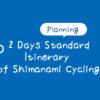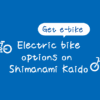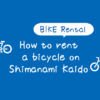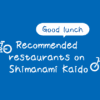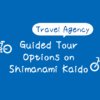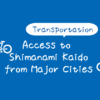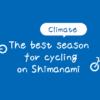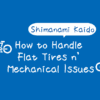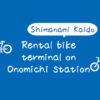Complete guide to cycling on the Shimanami Kaido

Planning a cycling trip on the Shimanami Kaido? Find everything you need to know—how to get there, where to rent bikes, route maps, travel tips, and sightseeing spots across the islands. Ideal for first-time visitors and international travelers.

Hello, I am Kawai, a cyclist living on the Shimanami Kaido. This is a personal website where I have gathered information for travel planning. It would be great if you could visit one of the most famous cycling routes in Japan.
The Shimanami Kaido
Why not experience the calm seas and nostalgic island landscapes at a gentle speed of 15–20 km/h—something you can’t feel from a car window? Cycling through these peaceful islands under your own power brings a unique sense of freedom and exhilaration. That’s one of the biggest appeals of cycling the Shimanami Kaido.
![[Illustration] Shimanami Kaido Cycling: Three routes connecting Honshu and Shikoku Honshu-Shikoku Bridge](https://touring-shimanami.com/wp-content/uploads/2025/06/locationofshimanami.png)
The Shimanami Kaido is one of Japan’s best-loved cycling routes, linking several islands across the scenic Seto Inland Sea. Built with bike tourism in mind, it features top-notch infrastructure and keeps getting better, drawing riders from around the world—many of them on rental bikes.
![[Illustration] Shimanami Kaido Cycling: Map illustration showing the locations of the islands on the Shimanami Kaido](https://touring-shimanami.com/wp-content/uploads/2025/06/isldshimanami.png)
The route crosses six main islands. Starting in Imabari, a city known for shipbuilding and towels, you’ll ride through Oshima, famous for its stone quarries; Hakatajima, known for salt production; and Ikuchijima, covered with lemon groves. The journey ends in Onomichi, a charming hillside town known for its cats. Each island has its own unique charm, making the ride truly memorable. Cycling through quiet farming and fishing villages offers a lasting sense of peace and tranquility.
![[Illustration] Cycling along the Shimanami Kaido: A conceptual diagram of a tour around bridges of various shapes](https://touring-shimanami.com/wp-content/uploads/2025/06/brdgeshimanami.png)
The bridges that connect the islands are a major highlight of the route. From soaring suspension bridges to unique circular and triangular structures, each one has its own distinctive design. It’s incredibly rare anywhere in the world to be able to ride a bicycle across such large and dramatic bridges. That’s why the Shimanami Kaido is recognized as one of the world’s top seven cycling routes and has been officially designated as a National Cycling Route in Japan.

This webpage is a Japanese page edited for English-speaking travelers, and the text is translated using chat GPT.
Beginner-friendly cycling routes
You don’t need to be an experienced cyclist to enjoy the Shimanami Kaido. Many riders are first-timers tackling their first long-distance ride or simply taking a relaxing cycling trip.
![[Photo] Cycling along the Shimanami Kaido: The great thing about the Shimanami Kaido is that even beginners can enjoy it](https://touring-shimanami.com/wp-content/uploads/2022/01/cycling-shimanamikaido-3.jpg)
With a public bike rental system that allows drop-offs at different locations, one-way cycling is easy and accessible. As long as you check in advance for rest areas, exit points, and what to do in case of trouble, even beginners can ride with confidence.
![[Photo] Cycling along the Shimanami Kaido: Rest areas provided by volunteer islanders](https://touring-shimanami.com/wp-content/uploads/2025/02/cycleoasis-pic-5.jpg)
Along the route, you’ll find “Cycle Oases” — volunteer-run rest spots where you can relax and use the facilities. If you encounter trouble, services like “Toso Rescue*” and mobile repair companies can come to your location. Everything is designed to support a worry-free cycling experience.
*A system in which certain car shops and gas stations offer simple repairs such as flat tires for a fee.
- 10 rental and return stations
- One-way rental system
- Sports bikes available
- Free rest stops
- Over 100 locations
- Restrooms and tools available
- Easy-to-follow road markings
- Maps and signs at key points
- Perfect for first-time riders
- Toso Rescue
- Cycle Saver service
- On-site repairs by private companies
The main route is clearly marked with a “Blue Line” painted along the edge of the road, guiding you toward key destinations such as Imabari and Onomichi. Maps at major intersections make it easy for first-time visitors to navigate.
- Best enjoyed over 2 days or more
- Choose info that suits your level
- Relax and explore the Seto Inland Sea islands
AD (Google AdSense)
Road, bridges & maps
Bicycle lanes and blue lines
![[Photo] Cycling along the Shimanami Kaido: The junction between the bicycle and pedestrian path and the moped path on the Kurushima Kaikyo Bridge](https://touring-shimanami.com/wp-content/uploads/2022/02/shimanamikaido-iriguchi.jpg)
The six bridges along the Shimanami Kaido each feature dedicated cycling paths separated from car traffic. This allows cyclists to ride safely on bicycle-only lanes parallel to the highways while crossing the bridges. On the islands themselves, riders use regular public roads. The uphill approaches to the bridges are designed with a gentle 3% incline, making them easier to climb.
![[Illustration] Cycling the Shimanami Kaido: Mapping the main route and island exploration courses of the Shimanami Kaido](https://touring-shimanami.com/wp-content/uploads/2025/06/main-optroutes.png)
On each island, you can choose cycling routes according to your fitness level and interests. In addition to the main route, there’re also optionally routes. Both are clearly marked with the Blue Line. The main route includes painted signs with distances like “Onomichi ○ km” or “Imabari ○ km,” and it generally offers the shortest and most direct path. The optionally route is labeled “Island Explorer.” Though it’s longer, it offers scenic coastal roads and beautiful beaches.
![[Photo] Shimanami Kaido Cycling: The blue line on the outer perimeter route and the main route](https://touring-shimanami.com/wp-content/uploads/2022/01/blueline-shimanamikaido.jpg)
Keep in mind that the distance and difficulty can vary significantly between the main route and optionally route, depending on the island. If you’re planning to leave the main route, be sure to confirm that the alternate path suits your skill level.
![[Photo] Shimanami Kaido Cycling: A small boat traveling between Onomichi and Mukaishima](https://touring-shimanami.com/wp-content/uploads/2024/07/ekimaetosen-2.jpg)
Note: Between Mukaishima and Onomichi, most cyclists take a ferry instead of crossing the Onomichi Ohashi Bridge, as its narrow bike lanes make it less safe and convenient.
Google Map for exploring the islands
ー Main route
ー Optionally Route
● Scenic Spots
● Restaurants
● Cafe & Shops
● Accommodations
● Rental Bike Terminal
I put together a Google My Map with my recommended cycling routes and spots along the Shimanami Kaido. Besides the shortest route with the least climbs, I also included some optional detours that are easy for beginners to try. You can view this map on your smartphone or tablet using the Google Maps app.

Having cycled the Shimanami Kaido more times than I can remember, I’ve gathered my personal recommendations here.
Maps you should get in advance
“CycloTourisme Shimanami," which has been active in cycle tourism and regional promotion for nearly 20 years along the Shimanami Kaido, publishes guidebooks and maps. The map is also available in English and is extremely popular as it is the most detailed cycling-specific map in this region.
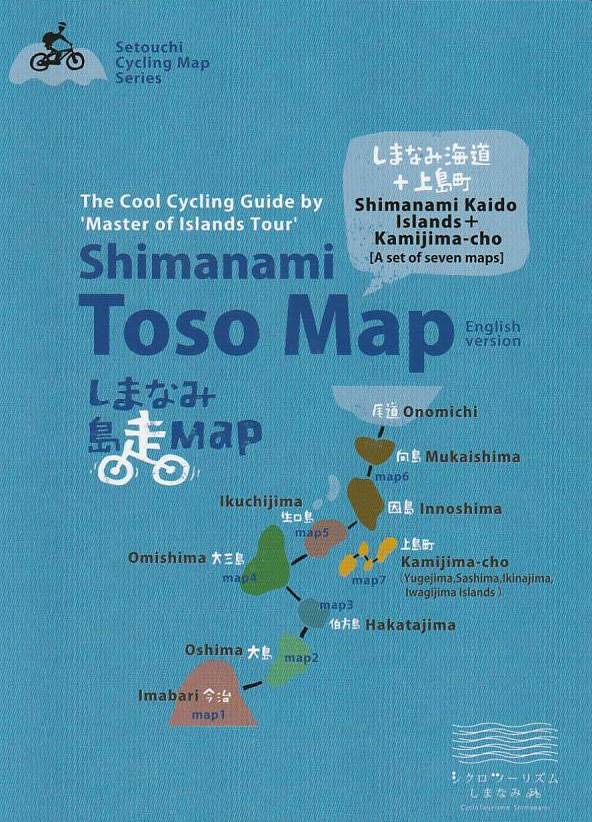
This product comes with a set of seven maps, each with a fairly detailed map for each island. I believe that getting your hands on this map will change your experience here. It can be purchased on Amazon.co.jp, and you can also buy it locally at Guesthouse CYCLONOIE in front of Imabari Station.
Distance & time required
Discussion on starting point
If you plan to cycle the entire Shimanami Kaido, your starting point will be either Onomichi Station in Hiroshima Prefecture or Imabari Station in Ehime Prefecture. From travelers’ blogs and social media posts, it seems that many people choose Onomichi as their starting point. Deciding which to start from is a common topic of discussion, but in reality, the difficulty level is about the same no matter which side you begin from.
![[Illustration] A map of the Seto Inland Sea region showing wind direction and speed on the Shimanami Kaido](https://touring-shimanami.com/wp-content/uploads/2025/06/windshimanami-1024x730.png)
For cyclists, riding into a headwind is as tough as climbing a hill. In this region, strong winds usually come from the west. On windy days, starting from Onomichi means facing a tough headwind. For beginners aiming to complete the Shimanami Kaido, considering the wind direction, starting from Imabari is generally recommended.
Distance of the Shimanami Kaido
The shortest route to cross the Shimanami Kaido is about 70 to 80 kilometers. While it’s possible to complete in one day, it might make for a rushed trip. Taking two or more days, with an overnight stay around Omishima or Ikuchijima, is definitely a better way to enjoy the journey. If finishing the entire route isn’t your goal, there are also model courses for one-day or half-day rides.

On the Shimanami Kaido, the total distance varies widely—from around 70 km up to over 200 km—depending on which local roads you choose on the islands. This variety of route options between the same start and end points, Imabari and Onomichi, is one reason why cyclists of all levels—from beginners to experts—are attracted to the Shimanami Kaido.
![[Illustration] Cycling along the Shimanami Kaido: Distances of each section of the main cycling route](https://touring-shimanami.com/wp-content/uploads/2025/06/distance-shimanami-e.png)
This map shows the main cycling route of the Shimanami Kaido (in blue) and the optionally routes (in light blue), with distances between black dots indicated in kilometers*. By adding up the distances of each segment along your planned route, you can estimate the total distance of your ride. At an average pace, travelers can travel around 10 km per hour.
*1 km ≒ 0.6 miles
Bridge heights and hills
Since large ships pass beneath them, the bridges along the Shimanami Kaido are built several dozen meters above the sea, which means there may be more ups and downs than you might expect. There are also small mountain passes on the islands, and the difficulty of your ride will vary depending on the route you take.
![[Illustration] Shimanami Kaido Cycling: Elevation difference between the main route and the outer route](https://touring-shimanami.com/wp-content/uploads/2025/06/updown-shimanami-e.png)
This diagram shows the height (in meters*) of the highest points on the bridges along the main route (in blue) and the elevations of major inland passes along the outer loop routes (in light blue). Bridge peak elevations are shown in blue, while major passes are marked in green.
*10 m ≒ 33 feet
![[Photo] Cycling along the Shimanami Kaido: Cyclists heading from Mukaishima to Innoshima](https://touring-shimanami.com/wp-content/uploads/2024/06/cyclista-shimanami-1024x512.jpg)
The diagram includes only significant passes along the main routes with elevations of around 30 meters or more. Most slopes along the Shimanami Kaido cycling routes are gently graded at about 3%, making them manageable even for beginners. Even if you decide to walk your bike up a 70-meter-high hill, it will take only about 15 to 20 minutes—so don’t hesitate to take it easy and push your bike when needed.

With these distance and elevation details, you can easily tailor a cycling route that suits your style.
AD (Google AdSense)
Route & plan
Two-days sample plan
With two days, you’ll have plenty of time not only to enjoy cycling but also to fully experience the highlights of the Shimanami Kaido—such as sampling local gourmet cuisine, stopping by cozy cafes, relaxing on scenic beaches, and visiting cultural spots along the way. The route is packed with charming places to explore, so it can take more time than expected when you stop to enjoy them.
![[Illustration] Cycling the Shimanami Kaido: A sample course for crossing the route in two days](https://touring-shimanami.com/wp-content/uploads/2025/06/2daysbestplan.png)
Here, I’ve put together a traveler-friendly model course that I consider the “basic” Shimanami Kaido cycling plan. If you’re aiming to ride the entire route, Omishima or Ikuchijima is roughly the halfway point, making them ideal places to stay overnight. This itinerary is perfect for beginners looking to combine cycling with sightseeing—please feel free to use it as a reference!
Review from a Two-Day RiderI cycled 80 km with my elementary school-aged daughter—splitting it into two days was definitely the right choice!
We stayed overnight on Omishima Island, and spending time on a Seto Inland Sea island was a unique and unforgettable experience.
We managed to visit all the cafes we had researched in advance and thoroughly enjoyed our little cafe tour along the way.
One-day touring option
Even if you don’t have two full days, you can still enjoy the Shimanami Kaido in just one. Shorter trips—like a full-day ride or even just a half-day outing—are absolutely possible. Whether it’s crossing just the Kurushima Kaikyo Bridge, exploring only Omishima and Ikuchijima, or cycling half the route, there are plenty of flexible plans that don’t require completing the entire course. With ferries and buses, you can create an itinerary that fits your schedule.
![[Illustration] Shimanami Kaido Cycling: A classic one-day bicycle trip plan](https://touring-shimanami.com/wp-content/uploads/2025/06/1dauplan-e-1024x644.png)
Rent a bike at the Imabari Station Cycling Terminal or Sunrise Itoyama and set out onto the Shimanami Kaido. You can return your bike at terminals on Hakatajima or Omishima and take a local bus back—both terminals are conveniently located near express bus stops. This one-day model course is perfect for those who want to “see how far they can go” without feeling pressured to complete the whole route. If reaching Omishima feels too ambitious, you can easily stop and return your bike at Hakatajima instead.

It’s a good idea to have a flexible plan that allows you to change your route or destination during your ride.
Rental bicycle
Rental bicycle services on the Shimanami Kaido vary widely in terms of bike types, rental fees, shop and terminal locations, and whether one-way returns are allowed. It’s important to choose an option that matches your travel plan and fitness level.
- Public rental service (Shimanami Japan) are the most commonly used
- Private rentals (bike shops) for experienced cyclists are also available
- Check the types of bikes offered and whether one-way returns are allowed
First, let’s take a look at Shimanami Japan’s public bike rental service, the most popular and budget-friendly option for many riders.
Option 1: Shimanami Japan (Public)
Shimanami Japan’s bike rental, a public service operated jointly by Ehime and Hiroshima Prefectures, is the most popular option for cycling the Shimanami Kaido. With a large fleet of bikes and affordable rental fees, it’s widely used by both beginners and casual cyclists. Its greatest advantage is the number of rental/return terminals, which offers flexibility and freedom for your cycling adventure.

The public rental system offers a wide variety of bikes—from standard city bikes to electric-assist models. If you’re unsure which bike to choose for your first Shimanami ride, we recommend the cross bike—a beginner-friendly model with a sporty feel and an upright riding posture like that of a city bike, making it easy to ride for first-timers.
Rental fees vary depending on the type of bike, and one-way return (drop-off) is included in the rental price. For example, if you rent a city bike or cross bike for a 2-day trip, the cost would be 3,000JPY per day, totaling 6,000JPY. Helmets are provided free of charge to ensure your safety on the ride.
| Bike Type | Price (JPY) | One Way |
|---|---|---|
| Cross Bike, City Bike | 3000 | ○ |
| Tandem Bike* | 4000 | × |
| Electrically Assisted Bike* | 4000 | ○ |
| E-bike* | 8000 | ○ |
*There are restrictions on which terminals can be rented.
Rental bike terminals
![[Photo] Rental bicycles on the Shimanami Kaido: a public bicycle rental service run by Shimanami Japan](https://touring-shimanami.com/wp-content/uploads/2023/03/shimanami-touring-bikes-2.jpg)
There are a total of 10 staffed rental cycle terminals along the Shimanami Kaido route. Even compared to other cycling regions across Japan, it’s rare to find such a well-developed network of manned rental facilities.
Recommended terminals for starting your ride
The terminals in Onomichi and Imabari, which are popular starting points, are relatively large in scale. While it’s not always the case, in my experience, the Imabari Station Cycling Terminal and Sunrise Itoyama tend to offer better-maintained and higher-quality bikes. (This is just my personal impression.)
| Area | Terminal | Facility Name | Open Hour* | Transportation |
|---|---|---|---|---|
| Onomichi | Onomichi Station Cycling Terminal | JR Onomichi Station | 8:00~19:00 | Onomichi Ekimae BS (Bus Stop), Onomichi St, Onomichi Port, Mukaihigashi BS |
| Imabari | Imabari City Cycling Terminal | Sunrise Itoyama | 8:00~20:00 | Tenbodai Iriguchi BS |
| Imabari | Imabari Station Cycling Terminal | JR Imabari Station | 8:00~20:00 | Imabari Ekimae BS, Imabari St |
*The bicycle rental terminal in Onomichi is relocated from the port to in front of the station in October 2025.
*[Winter] Open for short periods from December to February.
Convenient terminals for mid-ride drop-offs
Some rental terminals are conveniently located near bus stops, ports, or train stations, making them ideal places to end your ride if you need to cut your trip short. The terminals at Omishima, Hakatajima, Setoda (Ikuchijima), and Habu Port (Innoshima) are especially easy to access via public transportation after returning your bike.
| Area | Terminal | Facility Name | Open Hour* | Transportation |
|---|---|---|---|---|
| Innoshima | Habu Port | Central Parking Lot | 8:30~19:00 | Habu Port BS, Habu Port |
| Ikuchijima | Setoda Tourist Information Center | 9:00~17:00 | Setoda Port | |
| Omishima | Kamiura Rental Bike Terminal | Tatara Shimanami Park | 9:00~17:00 | Omishima BS |
| Hakatajima | Hakata Rental Bike Terminal | Hakata SC Park | 9:00~17:00 | Hakatajima BS |
*[Winter] Open for short periods from December to February.
Public rental bikes through Shimanami Japan can be reserved in advance via the official website. During peak holiday periods like Golden Week, bikes may be fully booked, and walk-in rentals could be unavailable. If you’re planning a trip during a busy time, make a reservation early to avoid disappointment.

With so many terminals available, the public rental cycle system makes flexible, carefree cycling possible.
Option 2: Private rental bikes
Now, let’s take a look at private bicycle rental services, such as local bike shops. These services offer unique advantages, such as high-quality bikes and more personalized support. Some even offer high-performance road bikes geared toward experienced cyclists.
Tabitasu
![[Screenshot image] Shimanami Kaido Cycling: Tabitasu website](https://touring-shimanami.com/wp-content/uploads/2022/08/tabitasu-website.jpg)
One popular option known for its flexibility and excellent support is the delivery rental bike plan by Tabitasu. With this service, rental bikes can be delivered and picked up at any location along the Shimanami Kaido. While extra charges may apply depending on the delivery area, it’s perfect for planning a flexible ride. The service also includes free luggage transport and roadside rescue in case of a flat tire, making it ideal for beginners as well.
Red Bicycles or Cyclefix
![[Photo] Shimanami Kaido Cycling: Exterior of a bicycle shop offering private bicycle rentals](https://touring-shimanami.com/wp-content/uploads/2023/09/red-bicyclesonomichi.jpg)
If you’re looking to rent a road bike instead of a cross bike, private services are a better choice. Two great options* are The Red Bicycles Onomichi, located in the Onomichi shopping arcade, or Cyclefix bike shop, within walking distance of JR Imabari Station. Both offer aluminum-frame road bikes, along with helmets and flat repair kits.
*These shops also support one-way cycling when used in combination with WAKKA’s bike return service, making your ride more flexible.
Giant Stores
![[Photo] Shimanami Kaido Cycling: GIANT Store Imabari at Imabari Station](https://touring-shimanami.com/wp-content/uploads/2022/02/shimanamikaido-biking-2.jpg)
The most well-known private rental service is GIANT Store*, operated by the world-famous Taiwanese bicycle manufacturer GIANT. These official stores offer high-quality sports bikes and are especially popular among experienced cyclists riding the Shimanami Kaido. Interestingly, GIANT opened stores in both Onomichi and Imabari after the company’s chairman, King Liu visited Japan in 2012 and cycled the Shimanami Kaido.
*For some types of bikes, a one-way plan is available for an additional fee.
| Area | Bike Shops | Open Hour | Closed |
|---|---|---|---|
| Ikuchijima | Tabitasu | – | – |
| Onomichi | Red Bicycles Onomichi | 8:00~17:30 | Wed. & Thurs. |
| Imabari | Cyclefix | 8:30~ (Reservation required) | Wed. |
| Onomichi | Giant Store Onomichi | 9:00~19:00 | – |
| Imabari | Giant Store Imabari | 9:00~19:00 | Tues. |

Depending on your budget and itinerary, take the time to find the bike rental service that best meets your needs.
AD (Google AdSense)
Ferry & bus
![[Illustration] Cycling along the Shimanami Kaido: convenient bus routes and ferry routes](https://touring-shimanami.com/wp-content/uploads/2025/06/busnboat-e.png)
Before the bridges were built, a network of ferry routes crisscrossed the Seto Inland Sea. Today, highway buses and local buses have taken over much of that role. Still, when traveling through the region, nothing beats a boat trip. It offers a chance to get up close to the calm waters and experience the traditional lifestyle that has long existed in the region.
Islands ⇔ Imabari / Onomichi
It’s convenient when rental cycle terminals are located near bus stops or ports. While ferries generally allow bicycles on board, buses typically do not. Therefore, it’s best to plan your trip under the assumption that you won’t be able to bring a bike onto the bus. A common pattern is to return your rental bike and then continue your journey by bus.
| Route | Bus Line | Description | Trips/Day |
|---|---|---|---|
| Innoshima ⇔ Onomichi | Local Bus | A local bus connecting Habu Port on Innoshima with Onomichi Station. Operated by three bus companies. | 18 |
| Innoshima ⇔ Fukuyama | Citrus Liner | A highway bus connecting Habu Port with Fukuyama Station. Operated by three bus companies. Designated boarding and drop-off stops. | 9 |
| Matsuyama / Imabari ⇔ Omishima | Rapid Bus | Buses connect Imabari with Oshima, Hakata Island, and Omishima. Express buses start in Imabari; limited express buses run between Matsuyama and Omishima via Imabari. | 14 |
| Imabari ⇔ Fukuyama | Shimanami Liner | A highway bus connecting Imabari and Fukuyama. Does not stop in downtown Onomichi. Designated boarding and drop-off stops. | 16 |
Some highway buses allow bicycles to be loaded into the luggage compartment if you are disassembled and packed in a dedicated bike bag. This may be a useful option for cyclists bringing their own bicycles. For those using rental bikes, however, this is not a realistic option, as disassembly is difficult and a special bike bag is required.
| Route | Operator | Description | Trips/Day |
|---|---|---|---|
| Onomichi ⇔ Ikuchijima | Setouchi Cruising | High-speed boat connecting Setoda Port on Ikuchijima and Onomichi Port. Cycle Ship Lazuli operates on select days. | 8 |
| Mihara ⇔ Innoshima | Habu Shosen | High-speed ferry connecting Habu Port (Innoshima) with Mihara Port in Hiroshima. Stops at Shigei Port (Innoshima) and Sagi Port (Sagi Island). | 7 |
| Innoshima ⇔ Imabari | Geiyo Kisen | Service between Habu Port (Innoshima) and Imabari Port, stopping at Oshima, Hakata Island, and Yumesima Islands. Some routes do not accept bicycles. | 4 |
| Omishima ⇔ Imabari | ・Omishima Blue Line ・Municipal Ferry | High-speed boats and ferries connecting Imabari Port with Okamura Island (Okamura Port) and Osaki Kamijima (Kinoe Port), stopping at Munakata Port on Omishima. | 6 |
The bus routes and ferry lines mentioned here are the ones most frequently used by travelers cycling the Shimanami Kaido. However, there are also many other transportation options, including local bus routes that circle the islands and small ferries connecting neighboring islands.
Imabari ⇔ Onomichi
Currently, there is no direct bus route or ferry line connecting Imabari Station and Onomichi Station at the two ends of the Shimanami Kaido. Travelers need to transfer along the way. The most common and straightforward method is to transfer between the Shimanami Liner highway bus and a local bus at the Innoshima Bridge Bus Stop (Innoshima Ohashi BS).

Depending on your budget and itinerary, take the time to find the bike rental service that best meets your needs.
AD (Google AdSense)
Accommodation
![[Illustration] Cycling along the Shimanami Kaido: A list of recommended accommodations](https://touring-shimanami.com/wp-content/uploads/2025/06/accommo-e-1.png)
When planning your Shimanami Kaido cycling trip, where you stay can greatly influence your route and experience. From guesthouses designed with cyclists in mind to traditional inns offering local cuisine and island hospitality, there’s a wide range of accommodation options along the route.
Cyclist-friendly hostels
![[Photo] Shimanami Kaido Cycling: Guesthouse "CyclonoIe" recommended for beginners](https://touring-shimanami.com/wp-content/uploads/2022/02/shimanami-hotel-1.jpg)
If it’s your first time cycling the Shimanami Kaido and you’re feeling a little unsure, consider staying at a bike-friendly accommodation or a lodge tailored for cyclists. Some lodgings have experienced staff who also work as cycling tour guides, offer mechanical support, or provide detailed local cycling information. Staying at one of these places ensures peace of mind and gives you access to valuable insider tips to make the most of your journey.
| Area | Accommodation | Description |
|---|---|---|
| Onomichi | ONOMICHI U2 | Hotel Cycle is located inside Onomichi U2 and allows you to check in while riding your bike. You can bring your bicycle directly into your room. |
| Mukaishima | Seesaw | A cozy pension-style inn with a great view of Onomichi’s nightscape. The owner is a cyclist and offers rental bikes and cycling support services. |
| Omishima | WAKKA | Stay in a cottage or dome tent near the seaside with a great view of the Tatara Bridge. Offers on-site bike repair and taxi services for cyclists. |
| Oshima | Oyado Ponpoko | This inn offers emergency rescue services for cycling troubles. Run by a couple who renovated a home near the Yoshiumi Rose Park. Only two groups per day, and safe for solo female travelers. |
| Imabari | Cyclonoie | Located very close to Imabari Station, this guesthouse is a popular base for Shimanami Kaido cyclists. Staff are certified cycling guides with deep local knowledge. |
Overnight stay on Ikuchijima or Omishima
![[Photo] Cycling along the Shimanami Kaido: Sawaki, a recommended accommodation for staying overnight on Omishima Island](https://touring-shimanami.com/wp-content/uploads/2022/02/shimanami-hotel-12.jpg)
If you plan to complete the Shimanami Kaido over two days, spending a night around the halfway point—Ikuchijima or Omishima—is highly recommended. These islands are ideal for a mid-journey rest. With the growing popularity of two-day cycling trips, many new guesthouses and private rentals have opened in this area. Below, I’ll introduce a few of my personal recommendations—places that offer comfort, charm, and a great base for continuing your ride.
| Area | Accommodation | Description |
|---|---|---|
| Ikuchijima | Suminoe Ryokan | A long-established inn over 100 years old with traditional architecture and a beautiful garden, located right near Setoda Port. Known for its delicious octopus dishes, a local specialty. |
| Ikuchijima | NEST | This guesthouse was renovated from an old ryokan near Setoda Port. Actively shares sightseeing info about Ikuchijima online. Great location for exploring Setoda. |
| Omishima | Ryokan Sawaki | A cyclist-friendly ryokan located near Oyamazumi Shrine. Indoor bike storage and maintenance tools are available. Enjoy a hearty dinner featuring local seafood. |
| Omishima | Tomarigi | A cozy guesthouse run by a pharmacist couple. Offers private rooms and spacious capsule-style dormitories. Great location for sightseeing and budget-friendly. |
| Omishima | I-Link | Popular among international cyclists, this accommodation offers private and dormitory rooms with an on-site café. Located near Tatara Bridge with a nearby convenience store. |
| Omishima | OHANA | A unique, handmade-style guesthouse with a whimsical atmosphere. Near Oyamazumi Shrine, making it convenient for sightseeing. Features a café and shop focusing on organic materials. |

With so many lodging options available along the Shimanami Kaido, you’re sure to find a great place to stay that fits your cycling plans.
Luggage delivery
Same-day baggage delivery service
For cyclists crossing the Shimanami Kaido in a single day, Sagawa Express offers a same-day luggage delivery service called “Shimanami Kaido Hands-Free Cycling” This allows you to send your luggage—such as suitcases—from one accommodation to another within the same day, between participating hotels in Onomichi and Imabari.
![[Photo] Cycling along the Shimanami Kaido: A flyer for Sagawa Express's same-day baggage delivery service along the Shimanami Kaido](https://touring-shimanami.com/wp-content/uploads/2022/01/sagawa-tebura-flyer.jpg)
Initially limited to hotels in the city centers of Onomichi and Imabari, the service has expanded to include accommodations on some of the islands along the route. There are also a few locations where you can send or receive your luggage even if you’re not staying overnight. No advance reservation is required—Simply let the hotel staff know at check-in if you’d like to use the service.
Other luggage delivery services
If same-day delivery isn’t necessary and next-day arrival is fine, you can also use standard services from Yamato Transport or Japan Post. And for those returning to their starting point, you might simply use coin lockers at the station or leave your luggage at cycling terminals.

Minimize the load on your back and ship any bulky items in advance.
AD (Google AdSense)
Spots
Lunch spots
I’ve carefully researched and selected the best places along the Shimanami Kaido where you can enjoy seafood, local specialties, and café-style meals during your cycling trip. From a cyclist’s point of view, we’ve featured places that are perfect for a relaxing lunch stop—restaurants that focus on local ingredients and offer unique flavors you can only find in this region.
Guided Tour
Along the Shimanami Kaido, several operators offer guided cycling tours. If you feel uncertain about your first cycling trip, or if you want to enjoy the unique experiences of a guided tour, I recommend booking one of these custom tours or joining a package tour.
| Guided Tour Operators | Features |
|---|---|
| Tabitasu Tours | Guided tours, rental bike delivery plans available |
| CycloTourisme Shimanami | Guided tours, event tour planning, guidebook publishing |
| Onomichi Tourism Association | Cycling package tours and walking tours in Onomichi |
| Wakka | Cycling support complex located on Omishima |
Access
You can reach both Onomichi and Imabari—the two starting points of the Shimanami Kaido cycling route—via JR trains, flights, or highway buses. From the Osaka area, it’s also possible to take a ferry to Imabari. The table below summarizes access options to the Shimanami Kaido. JR connections assume Shinkansen routes from major cities such as Tokyo and Osaka.
| Access | To Onomichi St. (Hiroshima Prefecture, Honsyu side) |
|---|---|
| JR | Transfer at Fukuyama Station from the Shinkansen to the JR Sanyo Main Line bound for Onomichi or Mihara. About 20 minutes. |
| Bus | Highway buses are available from cities such as Tokyo, Osaka, Kobe, and Hiroshima. |
| Airplane | Fly into Hiroshima Airport from Haneda, New Chitose, Sendai, Naha, and other airports. Take an airport shuttle to Mihara Station, then transfer to the JR Sanyo Main Line bound for Fukuyama. About 15–20 minutes. |
| Ferry | There are no long-distance ferries arriving at or departing from Onomichi Port. |
| Access | To Imabari St. (Ehime Prefecture, Shikoku side) |
|---|---|
| JR | From Okayama Station, transfer from the Shinkansen to the limited express “Shiokaze" bound for Matsuyama. About 2 hours to Imabari. |
| Bus | Highway buses are available from Tokyo, Osaka, Kobe, Hiroshima, Fukuoka, and other major cities. |
| Airplane | Fly into Matsuyama Airport from Haneda, Kansai International, Chubu Centrair, and other airports. Take a bus to JR Matsuyama Station, then ride the limited express to Imabari (about 40 minutes). A reservation-only limousine bus also runs directly from the airport to Imabari. |
| Ferry | Take the Orange Ferry overnight from Osaka Nanko to Toyo Port. A connecting bus from Toyo Port takes you to Imabari. |
If you’re bringing your own bike by train or plane, you’ll need to disassemble it and pack it in a special bike bag (called a rinko-bukuro in Japanese). Most highway buses do not allow bicycles, even if they are packed in bags.
Best season
Good timing for cycling
![[Photo] Cycling along the Shimanami Kaido: Cherry blossom season is one of the most beautiful moments](https://touring-shimanami.com/wp-content/uploads/2025/03/shimanami-saku.jpg)
The Shimanami Kaido offers a unique charm in every season, making it an appealing destination for cycling year-round. The region enjoys a mild Seto Inland Sea climate with relatively little rainfall, except for the rainy season in June and the typhoon season in late summer. The best times to cycle are Mid-February through the start of the rainy season, and again from the end of the rainy season until Mid-December.
| Season | Summer | Winter |
|---|---|---|
| Advantages | ・Long daylight hours ・Lighter clothing needed ・You can enjoy swimming in the sea | ・Clear and crisp air ・Season for lemons and citrus fruits ・No sweating ・Fewer tourists, more peaceful |
| Things to Note | ・Be prepared for heatstroke and sunburn ・Stay hydrated frequently | ・Be aware of early sunsets ・Dress appropriately for cold weather |
Peak cycling seasons are spring (April–May) and autumn (late September–November), when the weather is ideal and many cyclists visit the area. While winter (December–February) and the rainy season tend to be quieter with fewer travelers, winter rides can still be quite pleasant, especially for those seeking a calm, crowd-free experience.
- If you want to fully enjoy each of the islands, we recommend spending at least two days.
- Tips for choosing rental bikes and accommodations that suit your needs.
- In-depth information on the Shimanami Kaido cycling route is still limited in English.
This page compiles various information from the viewpoint of a local cyclist, aimed at English-speaking travelers coming to cycle the Shimanami Kaido. We hope this helps you plan your trip. Thank you for reading, and have a wonderful journey!


